MSI P55-GD65 - Mid-Range P55 for the Masses
by Gary Key on October 10, 2009 12:00 PM EST- Posted in
- Motherboards
MSI P55-GD65 Layout
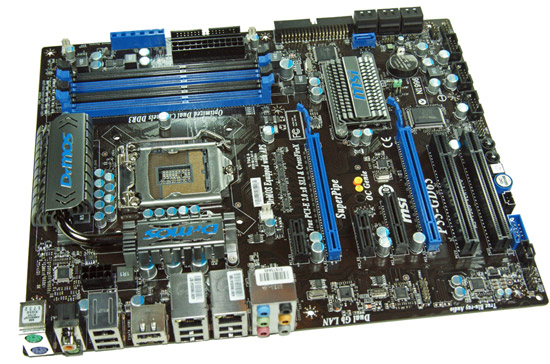
The GD-65’s board design is from MSI’s standard issue performance series. The basically all black design with a blue hue for certain accessories is a great look. The subtle gunmetal finished heatsink designs are tasteful and certainly leagues better than their old rollercoaster units.
It is obvious a lot of thought went in the general layout as it is also very good, but not perfect. The single blue JMicron powered SATA port is located on the other side of the six black P55 SATA slots and is difficult to reach in an CF/SLI setup. Of course, we still have a floppy port (why?) and an IDE port on a board that is suppose to take us into the future, not back to 1995.
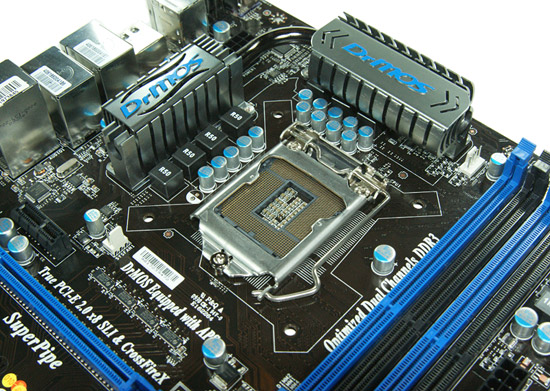
MSI utilizes a high quality DrMOS six-phase PWM setup on this board. Unlike traditional designs, each DrMOS phase circuit contains the MOSFET and driver IC in a single package. Based on our testing this setup will handle power requirements just as well as any eight to twelve phase design utilized on competing boards from Gigabyte, ASRock, ASUS or others. In fact, switching speeds are up to four times faster than traditional MOSFET/Choke setups along with a side benefit of cooler temperatures.
The GD65 supports dynamic power-phase switching along with onboard LEDs that notify you how many phases are active at any given time. MSI claims power is delivered to the CPU with 92% efficiency. We believe them based on clamp load measurements. Also, MSI has gone back to the drawing board on their heatpipe design with a new setup aptly named SuperPipes. No it is not a plumber’s dream come true, MSI’s heatpipes are now 60% larger at 8mm for improved cooling. In fact, DrMOS temperatures reached 36.3C under full load conditions with our i7/860 running at 4.3GHz with only our CPU cooler providing airflow around the PWM area.
The CPU area is generally open and will accommodate larger coolers like the Thermalright Ultra 120 eXtreme. Large push/pull coolers like the Vigor Monsoon III LT will block the first DIMM slot. A pattern we are seeing with just about every P55 board.
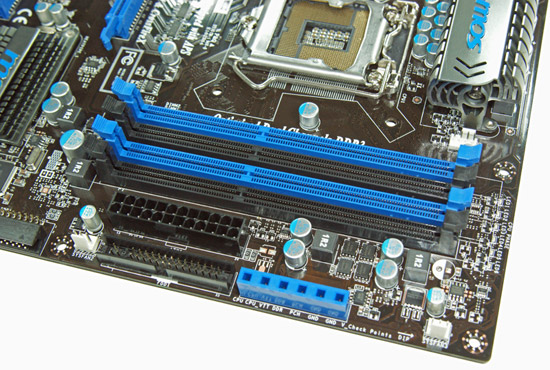
The floppy drive port (once again, why?), 24-pin ATX power connector, four DIMM slots, and V-Check block are located in the lower right hand corner of the board. This board supports dual channel memory configurations and 16GB of DDR3 memory when using 4GB DIMMS. Installing the memory with a video card inserted in the first x16 slot is easy.
The V-Check option is the blue plastic rectangle with six square holes. This box houses pins that offer voltage check points for VTT, DDR, CPU and PCH voltages. A user can take a multimeter and get a real-time readout of voltages instead of relying on BIOS or software readouts. We typically found readings to be within 0.01V~0.03V of what various software programs offered.
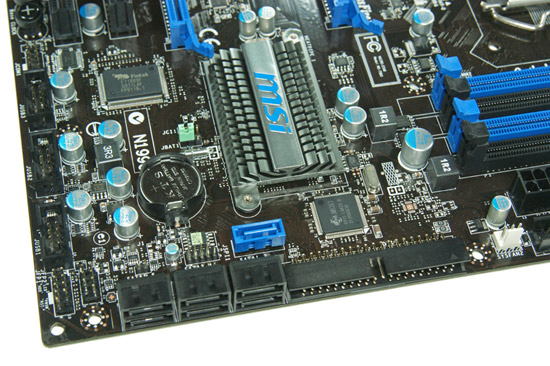
A low-profile heastsink design keeps the P55 chipset cool (not that it really needs it) and will not interfere with longer graphics cards in either slot. The six 3Gbps SATA ports offered by the P55 are along the edge of the board with right angle connectors. The only drawback is that this design can be troublesome in enclosures with the drive cage pushed up against the board but overall it is a preferred solution. The blue SATA port is run off the JMicron JMB363 as is the IDE port. We would rather see the IDE port dropped and the extra SATA port moved to the I/O panel as an eSATA option.
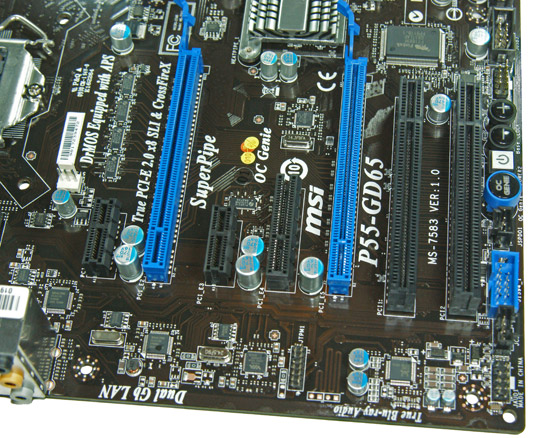
MSI includes two PCIe x16 slots (dual x8 with the second slot populated, both slots are run off the processor), two PCIe x1 slots (P55), two PCI slots (P55), and a PCIe x4 slot (P55). The second PCIe x1 and first PCI slot will be physically unavailable when utilizing a dual slot video card in both x16 slots.
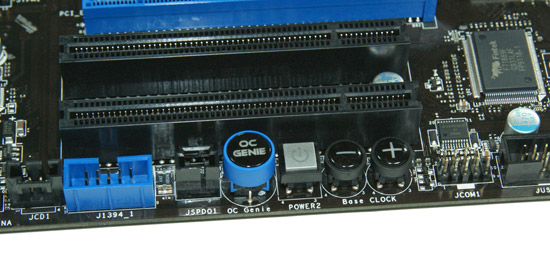
MSI includes their OC Genie and bclock buttons in addition to a power button. However, somebody probably fell asleep in the layout department as MSI failed to include reset and clear CMOS buttons. The two buttons most overclockers are going to use at one point or another.
MSI's "OC Genie" is a great technology that offers a hardware based solution to automatic overclocking. Basically, the user shuts down the system, presses the button, and starts the system again. The OC Genie will automatically take the system through a series of tests to overclock the CPU and memory. The whole process takes only a few seconds when it works.
We say “when it works” as we encountered several compatibility problems with various power supplies. Out of the eleven power supplies we utilize for compatibility testing, five of them caused OC Genie to lock hard, each time requiring a clear CMOS event to recover from the lock.
When it did work, our Core i5/750 was clocked to 3.3GHz and our Core i7/860 was clocked to 3.7GHz. We wished for a little more speed on the 750, but overall, the voltages and memory settings were in the safe zone and if a user is nervous about overclocking, this is a really quick and incredibly easy way to get additional performance from your system.
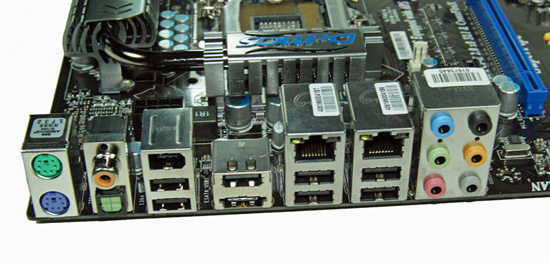
The I/O panel is loaded with goodies. We have seven USB 2.0 ports, PS/2 mouse and keyboards ports, a eSATA/USB powered port from the JMicron JMB363, IEEE 1394a port offered by the VIA VT6315N chipset, dual Gigabit Ethernet LAN ports via the Realtek RTL8111D chipset, optical out/coaxial out S/PDIF ports, and an audio panel that provides 8-channel audio output from the Realtek ALC 889 HD audio codec.
















43 Comments
View All Comments
MadMan007 - Sunday, October 11, 2009 - link
The lack of information regarding PCIe slot assignment when different slots are populated has been SORELY missing from all P55 mobo reviews. It's either laziness or an attempt to cover up shortcomings but it seems pretty important to me - people actually expect to use slots that are present on the board, ya know?I STILL haven't seen an answer to how many lanes the primary graphics slot keeps when the secondary graphics slot is populated with a 1x or 4x card! This affects anyone who has a graphics card and sound card, or TV tuner, or disk controller and given the layout of many boards you're likely going to have to use the secondary graphics slot for those devices.
I am also bothered by the lack of C2Q benchmarks. Loads of people have them and asking whether i5 in particular is a worthwhile upgrade is being ignored.
crab nebula - Tuesday, October 13, 2009 - link
There are two kinds of P55 mbs:1. Non SLI: The PCI Express 2.0 x16 link does not split.
2. SLI x8: The PCI Express 2.0 link splits into two x8 links, usually SLI-certified by NVIDIA
3. SLI x16: The nForce 200 chip is equipped for 2-way SLI: x16, x16 and 3-way SLI: x16, x8, x8.
Most mb of the first type also have a second PCI Express x16 slot which is connected to P55 and works at x4 (1.x in bandwidth).
MSI P55-GD65 is of the second type. If you insert a PCI Express device (of whatever lanes) in the second PCI Express x16 2.0 slot (electrically x8), the first PCI Express x16 2.0 slot also works only at x8.
A problem of P55-GD65 is that the severe (?) limitation of the PCI Express x4 slot is not mentioned in its product page or the manual at all. For example, suppose that a user is using a PCIe x1 sound card in the first PCIe x1 slot and a 2-slot graphics card. If he wants to use a PCIe x1 TV tuner card and insert it in the PCIe x4 slot, then he will suddenly find that his sound card stops working! So he has to use the second PCI Express 2.0 x16 for the TV tuner. Then this decreases the speed of the graphic card to x8!! Although practically this is not a big issue, this limitation still should be mentioned somewhere in the product page or the manual.
"the layout of this board is just fantastic, especially the PCIe/PCI layout." ?? It looks like Gary Key is simply ignorant of this. ASUS and ASRock mbs have much better board layouts in this respect: all expansion slots actually work!
MadMan007 - Tuesday, October 13, 2009 - link
Exactly the type of scenario that no mobo reviews have mentioned and which I was thinking of. Thank you for spelling it out.crab nebula - Tuesday, October 13, 2009 - link
Correction: "There are two kinds of P55 mbs" has to be "There are three kinds of P55 mbs". (The fourth type would be those that use Lucid Hydra 200.)lopri - Sunday, October 11, 2009 - link
I don't know how you don't see PCI Express slot information from the reviews so far? They have been clearly explained or are in the board specification page. There was even a special article regarding P55 chipset PCI Express.MadMan007 - Monday, October 12, 2009 - link
You need to reread and comprehend my post. I'm not asking for specs, obviously those are easy to find, but how lanes get assigned when slots are occupied especially with something other than a graphics card. I guess all reviewers are too lazy to put anything but one or two graphics cards in their test mobos.lopri - Monday, October 12, 2009 - link
I didn't go back and re-read the reviews, but at the time when I read them I was able to tell how the lanes are assigned on a given board. It's not like there are multitude of choices available.. All P55 boards so far (maybe except the one w/ NF200) support either a x16 lane or two x8 lanes from the CPU. Everything else belongs to the PCH and if I remember correctly all reviews made it clear when a physical x16 slot (x4 electrically) belongs to the south bridge.MadMan007 - Monday, October 12, 2009 - link
You still fail to comprehend and say it like I'm a moron who can't read a chipset diagram but your other link at least answered the question about the CPU-based lanes.lopri - Monday, October 12, 2009 - link
http://www.anandtech.com/mb/showdoc.aspx?i=3649">http://www.anandtech.com/mb/showdoc.aspx?i=3649MadMan007 - Monday, October 12, 2009 - link
That is a video card review so no it's not been spelled out in mobo reviews. It's what I figured but hoped the lane splitter chips might be smarter. Thanks for the link though.